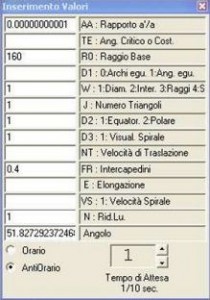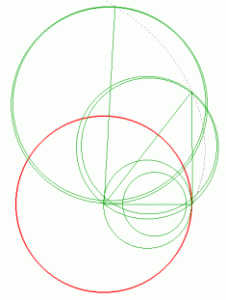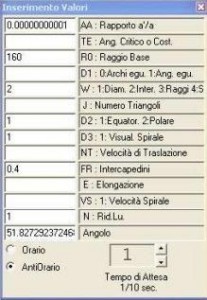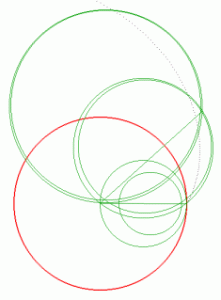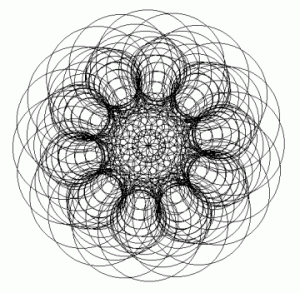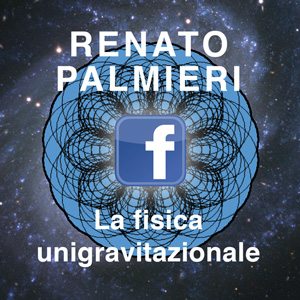The undulatory gravitation.
A) The gravitational propagation.
Chap.3.3 The “primitive” propagation (a ‘/ a = 0).
§ 1. The universal geometry of the undulatory gravitational function and its temporal scan (frequency) are embedded in the structural law of the elementary particle. It should be this way, and only the dull empiricism of modern physics could not think and see it. We have postponed to the sez. 6 the description of the wonderful device that produces, within the photonic horizon, the extraordinary effects described below. It is pointless to dismiss as “impossible” such effects as we are going to describe them, because their absolute reality is demonstrated by the undeniable natural truth of all the following discourse.
§ 1. La geometria universale della funzione ondulatoria gravitazionale e la sua scansione temporale (frequenza) sono impresse nella legge strutturale della particella elementare. Le figure 1 e 2, mentre appaiono il punto di partenza di una indagine che dall’infinitamente piccolo procede verso l’infinitamente grande, in realtà rappresentano il punto d’arrivo d’una nostra analisi che dal noto della concreta e generale esperienza umana, seguendo un percorso rigorosamente fisico e logico, è giunta al cuore ignoto della materia, e cioè alla soglia infinitesima dell’universo fisico, come nel titolo della sezione 6.
For a precise law of geometric composition, which we will give later, we will see to originate from the photonic waves those of the entire universe, up to the gravitation of galaxies and clusters of galaxies.
Costruzione delle figg. 1 e 2: implementare il sottoprogramma “Proragazione”; immettere i dati indicati in tabella; cliccare nel primo rettangolo bianco: comparirà nell’ultimo rettangolo il valore in gradi dell’angolo acuto alla base del triangolo rettangolo inscritto nella spirale; cliccare tre volte “Avanti”: il risultato sarà la figura 1; per disegnare la figura successiva, cliccare “Stop” e disimplementare nel menu “Grafici” il sottoprogramma usato precedentemente; quindi ripetere le medesime operazioni esecutive per ottenere la figura 2, naturalmente inserendo i valori della relativa tabella.
Le figure precedenti disegnano l’origine della funzione ondulatoria gravitazionale, a partire dall’emissione e propagazione di un’onda oltre l’ orizzonte fotonico, rappresentato dalla circonferenza di colore rosso. Geometria e meccanismo cineto-dinamico della “particella elementare” (fotone-gravitone, atomo assoluto) all’interno dell’orizzonte fotonico saranno argomento della sez.6, della cui conclusione le figure qui presentate fanno parte, mentre in questa sezione sono provvisoriamente all’inizio della trattazione. La loro assoluta realtà è dimostrata dalla innegabile verità naturale di tutto il discorso che ne consegue. Per una precisa legge di composizione geometrica, che daremo in seguito, vedremo originarsi dalle onde fotoniche quelle dell’intero universo, fino alla gravitazione delle galassie e degli ammassi di galassie.
Delle due fondamentali differenze tra la nostra fisica e quella corrente – l’unigravitazione e la propagazione eccentrica –, la prima costituisce un’idea semplice e chiara di per sé, difficile da capire e da accettare solo per l’insipienza della fisica teorica contemporanea. La seconda, benché stia da sempre sotto gli occhi di tutti in infinite forme naturali, ha costituito, anche da sempre, un reale ostacolo per il suo stesso riconoscimento da parte dell’esperienza umana, istintivamente portata a pensare una propagazione come una perturbazione concentrica di un mezzo (acqua, aria, ecc.).
Solo un’osservazione assolutamente pura poteva pervenire all’individuazione di un carattere “inconcepibile” – sebbene del tutto evidente -, quale l’eccentricità e la conseguente anisotropia, messo dalla Natura a fondamento della propagazione primigenia e tale che solo uno dei suoi due limiti matematici comporta onde e strutture concentriche.
La sola definizione possibile del fotone è – come si è detto – di carattere geometrico e cineto-dinamico, e nonsostanziale, poiché esso è la soglia ultima dell’universo fisico e quindi non ulteriormente analizzabile. Lo stesso si dica dell’etere, mezzo “intermateriale”, non definibile in termini chimici, ma solo nel suo aspetto funzionale, che è fisicamente necessario e sicuramente reale. Le domande circa la sostanza del fotone e dell’etere sono, quindi, semplicemente insensate e vanno respinte senza inutili discussioni, come di pertinenza di un discorso esclusivamente metafisico.
§ 2. The center of ‘”photonic organism“, represented in pictures 1 and 2 from the center of the photonic horizon does not disrupt, therefore, the ether in a symmetrically concentric way, according to the instinctive way of conceiving an undulatory phenomenon, but with an insufflante (blowing?) pulse. The spherical wave is, ie, “blown” as a soap bubble that inflates from a straw hole. Let’s imagine, in fact, an ideal straw with a hole in the side from which the bubble gradually increases, blown from one end of the same straw. Let’s imagine at the same time to rotate the tube perpendicularly to a plane passing through the hole (hence the plane of the screen): we will have pict.1, in which a tube is an ideal polar axis, perpendicular to the plane of the screen in the center of the photon; the wave is a sphere, internal tangent to the photonic horizon (starting position), seen in circular projection on the plane of the screen, with two compression fronts – external and internal – represented by two non concentric spheres (always seen in circular projection). These ones limit, between themselves, a spherical cavity , having a radial thickness decreasing from the point of injection up to a minimum in its antipode, marked by the extreme diameter of the wave.
Conventionally, we call the North Pole the extreme of the ideal straw that “sees” the counter-clockwise sense of rotation, the South Pole is the opposite, that “sees” its clockwise direction. The plane passing through the hole (the plane of the screen) is the equatorial plane of the wave, that is divided by it into two hemispheres.
§ 3. The initial position of the wave – of internal tangency – corresponds to the moment of issue. The photon, assumed in visually counterclockwise rotation around its axis (the “straw”), has blown up to that time within itself the wave along a ray, by dragging it jointly to its rotation with the same angular velocity. The moment of maximum expansion of the wave within the photonic horizon is the emission: the wave becomes independent from the photonic center (it continues its translational motion in space), while maintaining the double pulse expansion and rotation, but not the constant angular velocity. This will change in a constant spiral-speed – along a logarithmic spiral – of the antipode of the center of inflation, which is no longer the photonic center but an absolute geometrical point of space, around which the wave rotates indefinitely, while continuing to expand like one-way expansion of a bubble from the hole of the straw.
§ 4. Pict.1 shows, after the moment of issue, two successive positions of the same wave separated by equal infinitesimals, with the logarithmic spiral traced by the cosmological equation as the path followed by the extreme of the diameter of the wave at a constant spiral speed: the two arcs of spiral, rectified, are linearly equal.
It is understood that, while the wave rotates from the position of the issue to the next, the photonic center is moving in space, and therefore the red circle of his horizon should follow it: which, of course, does not appear in the figure. But we will show below graphically the reality of the phenomenon.
§ 5. The program calculates the initial volume of the spherical interspace for certain exemplifying parameters and maintains it constant during the propagation of the wave. This means, as it is evident from the figure, that the radial thickness of the interspace to the corresponding points of the wave decreases continuously in proportion as the wave propagates.
The interspace volume corresponds to the global gravitational intensity of the wave, which is therefore constant during the propagation (except that after each event “pulse”). The radial thickness of the same cavity corresponds, on the contrary, to the punctual gravitational intensity, which decreases gradually for corresponding points of the surface wave during propagation. The radial thickness, on each wave, and thus the punctual intensity, has a maximum at the point of injection and decreases to a minimum in its antipode.
§ 6. The physical meaning of the above is clear and in perfect compliance with the data of the most common experience. We will now explain functionally the phenomenon of gravitation, which for the mainstream physics is the most mysterious and inconclusive one could imagine. The height of ridiculousness was reached with the true silliness that is the Einsteinian, “curved space” which everyone pretends to understand, but nobody knows what it means. You will finally understand the strictly physical meaning of the concept of “force” that for classical physics is impossible to define. The spherical cavity is physically an area of rarefaction of the ether, which extends between two compressed edges, as before we said: it creates a “gravitational hill” with its enlargement to the point of injection to proceed from its antipode – with a centripetal attractive effect, therefore,– and it is the only way to go by external photonic centers in their space motions. Gravitational waves are “roads” that photons launch each other, covering it exclusively along arcs and intersections of waves produced by other photons.
§ 7. The pict.2, apparently a little different from 1, shows a distinct appearance of the phenomenon: that of the frequency or rate of emission of waves by the photon. They are represented, therefore, not three successive positions of a same wave in time, but three waves, subsequently issued, distant from each other an equal infinitesimal.
But we must warn that, in this case, the drawing is only illustrative and it does not correspond proportionally to the actual rate of photonic emission, which will be specified only in sez. 6. In the figure is also assumed an ideal situation, namely that of a photonic center standing in the space, with waves that, once made, are propagated by rotating around a given point of injection, and then with a shared equatorial plane (the plane of the screen ). This is an extreme case, but it is useful to consider its consequences in the natural complications of the phenomenon, as we shall see later.
§ 8. Picture 2 does not draw the ideal diameters of the waves or their positions, as in pict. 1, but their real intersections. These are, in threedimensional space, some circles, which, projected on the equatorial plane of propagation (here, the plane of the screen), appear as segments joining the points of intersection between the equatorial circumferences of successive waves. These segments are, in fact, identified with the diameters of the circles of intersection between successive spherical waves: they are two in pict 2, between the first and second and between second and third wave. (Pay attention, however, to the temporal order: the oldest wave is the largest, the last in chronological order is the one in emission, internal to the photonic horizon).
It is a very important element, because the circles of intersection among waves are the geometrical locus of transition from wave to wave of the attracted matter towards the attractive one. Without them it would be impossible the gravitational transit of the photonic centers in the road network referred to in § 6, because the gravitational motions take place only within the spherical cavities of the waves and their spatial intersections. Therefore we have defined the ether an ” intermaterial means”: matter, consisting only of photonic centers, runs only within the areas of rarefaction of the ether, between the two compressed fronts of the waves.
§ 9. The window Display values provides moment by moment the mathematical data of geometrical procedure in progress. Let us leave aside now their illustration, which we will carry out as soon as possible.

